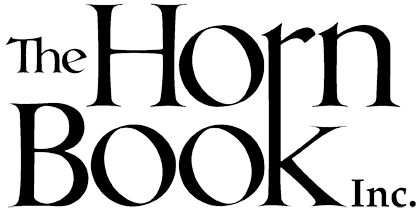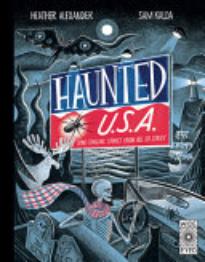Folklore--United States
38 Reviews
(3)
4-6
Illustrated by
Sam Kalda.
Each spread of this book jovially shares a spooky legend from one of the fifty United States and Washington, D.C. The demeanors of the spirits covered — human, animal, and cryptid — range from friendly to antagonistic, and many of the haunters are helpful. Sympathetic to the ghosts, the narrator leans into the varying historical origins and mystery of each tale. The accompanying, mostly monochromatic pencil illustrations in muted tones are more alluring than frightening, making for an attractive, occasionally chilling package. “A Ghost Hunter’s Guide” and a “Spooky Glossary” are appended.
Reviewer: Monica de los Reyes
(2)
YA
When Catalina's pa dies after drinking cider made from a poisoned apple, "wind burst through the cabin like a ferocious intruder...a man, but his skin rose and fell in patchy, lopsided ridges. Bark? Green leaves with serrated edges sprouted from his hair. Birds circled his head." It's Johnny Appleseed--he goes by "John, actually"--and this Faustian take on the folk hero posits that he was compelled to plant poisoned apple seeds across North America after selling his soul to the devil. John has come for Catalina's younger brother, Jose Luis, and she sets off to save him by tracking one of John's birds. Soon she finds a companion in a young lumberjack, Paul, who is also hunting John. They gradually open up to each other and acknowledge their growing mutual attraction as they face more harrowing forest obstacles. Interspersed with third-person narration are first-person accounts from John detailing his desperate dealings with the maleficent "banker." Krause's North American frontier is diverse and filled with historically rooted fantastical elements (e.g., "tree weepers": sobbing canopy-dwellers dressed in worn period gowns). Her lyrical prose shines in descriptions of nature: "Late summer rains had fattened the wilderness, making it full and dense, as though it wore a coat it had made for itself." Catalina's emotional growth, including reflections on her maternal Mexican heritage (her mother died years earlier) and identity as a poet, and several surprising plot twists carry this riveting tale to a satisfying conclusion.
Reviewer: Monica de los Reyes
| Horn Book Magazine Issue:
November, 2023
(2)
4-6
Wait, Paul Bunyan wasn't born in Maine and cradled in the Bay of Fundy before making his way to Minnesota's north woods with Babe, his blue ox? It turns out his legend was promulgated in a Red River Lumber Company marketing campaign as a way to promote both the timber industry and, according to an introduction by Lee Francis IV (Pueblo of Laguna), "the common colonial theme of settling various lands and regions that once belonged to Indigenous peoples to make way for 'American civilization.'" This caution paves the way for the graphic-format tale, which imagines a train making its way through Minnesota's winter in 1914, stopped in its tracks by an accident up ahead. The passengers while away the time with stories. Red River's advertising manager delights many with his tales of Paul Bunyan (who looks, in the scratchy ink-and-watercolor panels, a lot like the storyteller in buffalo plaid). The yarns have some detractors, who make note of the clear-cut forests and the displacement of Native peoples--and Van Sciver gives them the last word, effectively complicating the folk-her narrative for both characters and readers. The book concludes with essays by Indigenous contributors Deondre Smiles (Leech Lake Band of Ojibwe) and the book's coauthor and illustrator Myles (Spirit Lake Dakota), and a map of the region from a Native perspective. It's a busy, thoughtful presentation that will leave readers with much to ponder about the making of this strand of the American mythos.
Reviewer: Vicky Smith
| Horn Book Magazine Issue:
November, 2023
(2)
4-6
Illustrated by
Vicki Trego Hill.
American Southwest storyteller Hayes retells ten folktales (five new and five from the original 1994 edition) with straightforward, often funny text in both English and Spanish. In these tales, women's cunning saves the day from people with unsavory intentions or unfortunate habits. Soft, realistic black-and-white illustrations, some new and some reused from the previous edition, open the stories. Back matter includes notes about the origins of each tale.
Reviewer: Shoshana Flax
| Horn Book Magazine Issue:
July, 2019
(4)
4-6
Illustrated by
Jagdish Chitara.
An unusual fusion of the African American Brer Rabbit tales with Indian folk art. Told by performance poet Flowers using elements of Black Vernacular English, the stories are illustrated in striking black, white, and red in the Mata-Ni-Pachedi tradition of textile art from Gujarat. Includes a CD of music and film that, like the handsome book, may be of greatest interest to adult folklore enthusiasts.
Reviewer: Melinda Greenblatt
(3)
4-6
Illustrated by
Tom Mead.
Supposed true stories of cryptids teach young readers to survive the North American wilderness. The twenty short tales of fearsome creatures inspired by American folklore read like the guidebook of an eccentric monster hunter. Johnson's snarky humor lightens the weird and genuinely scary stories; readers of all ages will cower at Mead's creepy glow-in-the-dark illustrations. An appendix contains "facts" about each creature.
Reviewer: Jenn Matters
(4)
K-3
Illustrated by
C. B. Canga.
Hals Halson, bent on proving himself as the greatest lumberjack, strides into camp. Lonely Paul Bunyan would rather start a friendship than a competition, but he's forced to best Hals before the latter will bury the hatchet. The story, aptly hyperbolic, is a little weak on plot. Digital-looking cartoon illustrations using woodlike textures and sharp angles reflect the characters' shared skills.
Reviewer: Rebecca Reed Whidden
(3)
4-6
Clockwork Dark series.
In this installment, set at the Chicago World's Fair, the characters seek to destroy the Magog and his evil machine. As each person overcomes his or her own "black clockworks," they build the strength and resolve to defeat the villain together. Bemis continues to unite Southern folklore and steampunk fantasy as readers are carried along on a journey of suspense and intrigue.
Reviewer: Ashleigh Finn
(4)
K-3
The fourteen tales in this book have been adapted from versions published in the early part of the twentieth century. Subjects include Johnny Appleseed, Davy Crockett, the Tar Man, and Sweet Betsy from Pike. The retellings are cursory, with the results being a little flat. Palazzo's pastoral sketchlike illustrations recommend the volume.
Reviewer: Miriam Lang Budin
(3)
4-6
Clockwork Dark series.
This sequel to The Nine Pound Hammer continues the story of Ray, a Rambler; his sister Sally, a seer; and siren Jolie. They're searching for the Wolf Tree--source of the human spirit and key to destroying the Darkness overtaking the American Great Plains. Interweaving American tall tale, Native American folklore, and elements of steampunk, Bemis presents another engaging story of spirituality and intrigue.
Reviewer: Ashleigh Finn
(3)
K-3
Illustrated by
Marjorie Priceman.
Griffin describes how in 1775 a sixteen-year-old North Carolina horsewoman took the ride of her life to warn of the Redcoats' approach. Priceman's expressively angular, bold-hued gouache and ink paintings accentuate the urgency of Betsy's mission. An author's note tells more about the folkloric figure: "It cannot be proved that Betsy Dowdy really existed, but her legend lives on."
Reviewer: Rita Soltan
(4)
K-3
Illustrated by
Will Hillenbrand.
A backwoods peddler barters for a wedding dress for his daughter. Although the sequence of trades seems unnecessarily random, and the ending is adult (implying a reluctance on the bridegroom's part not earlier evident), the author's language is lively and engaging, and the refrain ("And one fine trade it is!") should hold readers' interest. Warm, cheerful watercolors add appeal and humor.
Reviewer: Martha V. Parravano
(3)
K-3
Illustrated by
Megan Lloyd.
Davy Crockett's "wildcat" dance moves (thanks to a thornbush burr in his derriere) threaten to upstage the spring frolic honoree, Miss Sally Ann Thunder Ann Whirlwind. The "angeliferous" Sally resorts to sabotage (spilling butter, pickles, and other items), but Davy's nonstop dancing (and cooking!) finally impresses her. Lloyd's pine-needle-bordered oil paintings play up the humor and hyperbole in Miller's tall tale. Bib.
Reviewer: Tanya D. Auger
(3)
4-6
Clockwork Dark series.
Ray, an orphan, winds up on a train peopled with traveling medicine show performers. He quickly learns the show is just cover; they're all determined to destroy the evil Gog. What distinguishes this fast-paced adventure is the nineteenth-century rural American setting, where both characters and circumstances are deeply influenced by regional folklore and the "hoodoo" traditions of the Deep South.
Reviewer: Betty Carter
(3)
K-3
Illustrated by
John Kanzler.
Storyteller MacDonald offers an enjoyable version of this cumulative tale, in which an old woman can't return to her little boy because her pig refuses to cross a bridge on the way home from the market. Two brief songs (music is included) encourage listener participation. Lively illustrations provide humorous portrayals of the story's stubborn animal characters.
Reviewer: Martha Sibert
(2)
4-6
Illustrated by
Laura Bannon.
This Newbery Honor Book includes nineteen tall tales that detail the exploits of super-cowboy Pecos Bill in the American West. The stories were originally told at round-ups and around campfires, and Bowman's writing exemplifies the gusto and broad humor of cowboy life. Strong-lined black-and-white drawings illustrate the tales.
Reviewer: The Horn Book, Inc.
| Horn Book Magazine Issue:
May, 2037
(3)
K-3
On My Own Folklore series.
Illustrated by
Lisa Carlson.
These entertaining books adapt for young readers the oft-told tales of larger-than-life North American folk heroes. The titles' humor, richly colored (although sometimes muddy) illustrations, and accessible text sprinkled with colloquialisms combine for an enjoyable read. A general discussion of folklore introduces each title, providing examples and definitions; Paul Bunyan and Pecos Bill include age-appropriate further reading and websites. Review covers these On My Own Folklore titles: Calamity Jane, John Henry, Paul Bunyan, and Pecos Bill.
Reviewer: Laura A. Woollett
(3)
K-3
On My Own Folklore series.
Illustrated by
Mark Oldroyd.
These entertaining books adapt for young readers the oft-told tales of larger-than-life North American folk heroes. The titles' humor, richly colored (although sometimes muddy) illustrations, and accessible text sprinkled with colloquialisms combine for an enjoyable read. A general discussion of folklore introduces each title, providing examples and definitions; Paul Bunyan and Pecos Bill include age-appropriate further reading and websites. Review covers these On My Own Folklore titles: Calamity Jane, John Henry, Paul Bunyan, and Pecos Bill.
Reviewer: Laura A. Woollett
(3)
K-3
On My Own Folklore series.
Illustrated by
Craig Orback.
These entertaining books adapt for young readers the oft-told tales of larger-than-life North American folk heroes. The titles' humor, richly colored (although sometimes muddy) illustrations, and accessible text sprinkled with colloquialisms combine for an enjoyable read. A general discussion of folklore introduces each title, providing examples and definitions; Paul Bunyan and Pecos Bill include age-appropriate further reading and websites. Review covers these On My Own Folklore titles: Calamity Jane, John Henry, Paul Bunyan, and Pecos Bill.
Reviewer: Laura A. Woollett
(3)
K-3
On My Own Folklore series.
Illustrated by
Paul Tong.
These entertaining books adapt for young readers the oft-told tales of larger-than-life North American folk heroes. The titles' humor, richly colored (although sometimes muddy) illustrations, and accessible text sprinkled with colloquialisms combine for an enjoyable read. A general discussion of folklore introduces each title, providing examples and definitions; Paul Bunyan and Pecos Bill include age-appropriate further reading and websites. Review covers these On My Own Folklore titles: Calamity Jane, John Henry, Paul Bunyan, and Pecos Bill.
Reviewer: Laura A. Woollett
38 reviews
We are currently offering this content for free. Sign up now to activate your personal profile, where you can save articles for future viewing.























